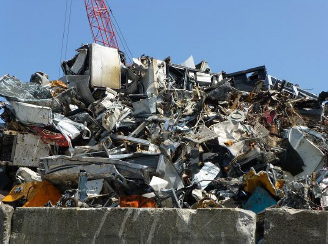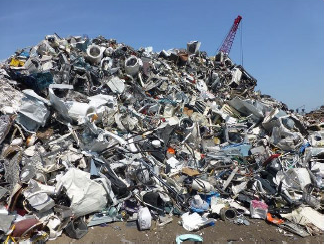- Waste management in Japan
- Circular economy in Japan
- Waste management in Asia
- Disaster waste management
New Regulations on Zappin (Mixed Metal or Miscellaneous) Scrap
English translation: May 2023
What is zappin scrap?
I don’t think that many people are familiar with the Japanese term “zappin (i.e., mixed metal or miscellaneous) scrap.” Generally, zappin scrap refers to various used items discharged from demolition sites, factories, general households and offices that are not yet dismantled nor separated including steel, nonferrous metals and plastics. My previous article dated 24 January 2011 (in Japanese only) introduced it as “mixed metal scrap (zappin).” Japanese exporters have used the terms “zappin” or “mixed metal,” but the Ministry of the Environment (MoE) has called it “zappin scrap” since around 2014.
A large amount of zappin scrap has been exported to China where it appears to have been dismantled, separated and recycled. There are mainly two types of zappin scrap: “household zappin” mainly consisting of home appliances and “industrial zappin” that are mainly switchboards, motors and cables.
I have been pointing out that zappin scrap could pose problems from three viewpoints: controlling hazardous substances, recovering materials, and reducing fire risks. Specifically, hazardous substances including lead and fluorocarbons contained in zappin scrap are exported without being properly controlled. Even target appliances for which laws have been established for domestic recycling are easily exported as resources. Fires often break out at zappin scrap storage sites on ships and in port areas. Despite these problems, the export of zappin scrap was not regulated by Japanese laws before. It was not covered by Japan’s Basel Act (a domestic law to regulate transboundary movements of hazardous wastes stipulated by the Basel Convention) because it was difficult to prove the existence of hazardous substances exceeding the threshold value. It was also not covered by the Waste Management and Public Cleansing Act because it can be priced and sold.
 Industrial zappin
Industrial zappin Household zappin
Household zappin“Hazardous used appliances” regulated by the amended Japan’s Waste Management Act
Japan‘s Waste Management and Public Cleansing Act (referred to as “Waste Management Act”) was amended in June 2017 to add a new regulation on zappin scrap. To be more specific, Article 17-2 of the Act has defined certain items to be regulated by the law as “hazardous used appliances (or listed e-waste).” The Act obliges hazardous used appliance storage and disposal operators to submit a notification to prefectures and comply with the storage and disposal standards. On the part of prefectures, the amendment has enabled them to take necessary measures such as on-site inspections. After these changes, the storage and disposal of zappin scrap are now regulated in a way similar to industrial waste although its collection and transport are left unregulated. The reason for the Act to use the term “hazardous used appliances” was that “zappin scrap” can be interpreted in various ways and was difficult to be adopted as a legal term. The Act defined “hazardous used appliances” as “certain parts of collected used appliances (not those originally categorized as waste) that still have resource values and may cause damage to human health or living environment if improperly stored or disposed of.” The Act also stipulates that such appliances be specified by a Cabinet Order or a MoE Ordinance. The ministry carefully reviewed candidate items and has presented a draft list with four items targeted by the Home Appliance Recycling Act and 28 items targeted by the Small Home Appliance Recycling Act. Public comments have been invited from 14 November 2017 to 13 December 2017, and the final list will be published before 2018 (at the time of this writing). The Act does not cover business equipment that can be easily distinguished from home appliances, but it can be added to the target list depending on actual situations in the future.
As for the application of the Waste Management Act, there have been cases in which used appliances escape the regulation based on the claim that they still have a resource value and that it is therefore not waste. In order to prevent this situation, efforts have been made to capture used items that should be regulated. For example, Japanese Supreme Court adopted a theory in 1999 to determine comprehensively which waste should be ruled by this Act. Other similar administrative guidelines have been issued since then so that used appliances would not be judged as non-waste based on their trade value alone. However, since the business dealers had continued to claim that the equipment that they handle is non-waste on the basis of its trade value, the June 2017 amendment of the Waste Management Act was a breakthrough in the sense that it finally made this non-waste “hazardous used appliances” as one of the target items.
What the regulation on “hazardous used appliances” will bring about
The enforcement of the amended Waste Management Act in April 2018 will be the start of regulating zappin scrap storage and disposal operators in Japan who had been totally unregulated before. The amendment will oblige them to take appropriate measures: notifications to prefectures on storage and disposal of zappin scrap; measures at storage sites (e.g., installation of enclosures and signboards at the sites, prevention of leachate infiltration into the ground, and establishment of height limitations for piles of stored items); and measures at disposal sites (e.g., prevention of emissions and spills of hazardous substances). In addition, the amended Act will enable prefectures to conduct on-site inspections and issue orders to improve the situation.
Previously, I estimated that the export of zappin scrap to China was about 1.3 – 2 million tonnes per year. In Japan’s trade statistics, zappin scrap is categorized as “steel scrap,” and more recent statistics suggest that its annual export volume has slightly decreased. The business dealers who had inappropriately traded used home appliances as zappin scrap will have more difficulties having such deals. Consequently, there may be cases that they completely stop exporting zappin scrap in the future. People who go around the city collecting unused appliances from households and selling them to these zappin scrap dealers may also reduce collections of these items. Since most of the items designated as “hazardous used appliances” are either the four items of home appliances or small home appliances subject to the Home Appliance Recycling Act and the Small Home Appliance Recycling Act (including business equipment that cannot be easily distinguished from home appliances), it is expected that recycling will be promoted in accordance with these acts. As for the recycling of small home appliances, not many municipalities have applied the Act to the items in all the 28 target categories. It is thus desirable to improve this situation as well as the awareness of citizens on proper discharging of these items.
For more information
- A. Terazono, et al. (2011) Examination of scrap-mixed metal generation and export from the perspectives of hazardous materials control and material recovery. Journal of the Japan Society of Material Cycles and Waste Management, 22(2), 127-140
- A. Terazono (2015) International material cycles of used electric appliances: toward appropriate management of E-waste in Japan and Asia. Kankyogi, 57 (in Japanese only)


